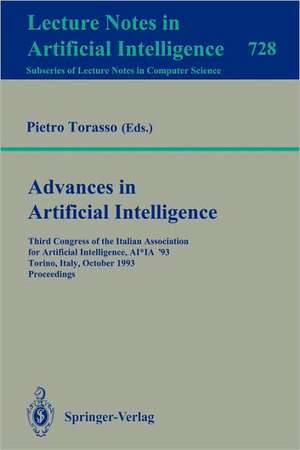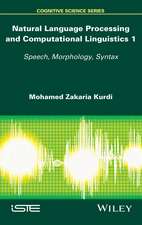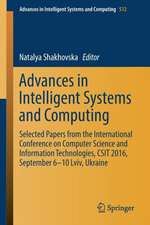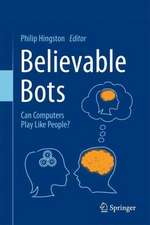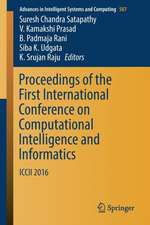Advances in Artificial Intelligence: Third Congress of the Italian Association for Artificial Intelligence, AI*IA `93, Torino, Italy, October 26-28, 1993. Proceedings: Lecture Notes in Computer Science, cartea 728
Editat de Pietro Torassoen Limba Engleză Paperback – 5 oct 1993
Din seria Lecture Notes in Computer Science
- 20%
 Preț: 1061.55 lei
Preț: 1061.55 lei - 20%
 Preț: 307.71 lei
Preț: 307.71 lei - 20%
 Preț: 438.69 lei
Preț: 438.69 lei - 20%
 Preț: 579.30 lei
Preț: 579.30 lei -
 Preț: 410.88 lei
Preț: 410.88 lei - 17%
 Preț: 427.22 lei
Preț: 427.22 lei - 20%
 Preț: 596.46 lei
Preț: 596.46 lei - 15%
 Preț: 448.04 lei
Preț: 448.04 lei - 20%
 Preț: 353.50 lei
Preț: 353.50 lei -
 Preț: 389.49 lei
Preț: 389.49 lei - 20%
 Preț: 309.90 lei
Preț: 309.90 lei - 20%
 Preț: 645.28 lei
Preț: 645.28 lei - 20%
 Preț: 763.23 lei
Preț: 763.23 lei - 15%
 Preț: 580.46 lei
Preț: 580.46 lei - 20%
 Preț: 310.28 lei
Preț: 310.28 lei - 20%
 Preț: 655.02 lei
Preț: 655.02 lei - 20%
 Preț: 1183.14 lei
Preț: 1183.14 lei - 20%
 Preț: 340.32 lei
Preț: 340.32 lei -
 Preț: 449.57 lei
Preț: 449.57 lei - 20%
 Preț: 591.51 lei
Preț: 591.51 lei - 18%
 Preț: 938.83 lei
Preț: 938.83 lei - 20%
 Preț: 337.00 lei
Preț: 337.00 lei - 20%
 Preț: 649.50 lei
Preț: 649.50 lei - 20%
 Preț: 607.40 lei
Preț: 607.40 lei - 20%
 Preț: 1414.79 lei
Preț: 1414.79 lei - 20%
 Preț: 1024.44 lei
Preț: 1024.44 lei - 20%
 Preț: 583.40 lei
Preț: 583.40 lei - 20%
 Preț: 453.32 lei
Preț: 453.32 lei - 20%
 Preț: 575.49 lei
Preț: 575.49 lei - 20%
 Preț: 1075.26 lei
Preț: 1075.26 lei - 20%
 Preț: 585.88 lei
Preț: 585.88 lei - 20%
 Preț: 825.93 lei
Preț: 825.93 lei - 17%
 Preț: 360.20 lei
Preț: 360.20 lei - 20%
 Preț: 763.23 lei
Preț: 763.23 lei - 20%
 Preț: 340.32 lei
Preț: 340.32 lei - 20%
 Preț: 504.58 lei
Preț: 504.58 lei - 20%
 Preț: 369.13 lei
Preț: 369.13 lei - 20%
 Preț: 580.93 lei
Preț: 580.93 lei - 20%
 Preț: 343.62 lei
Preț: 343.62 lei - 20%
 Preț: 350.21 lei
Preț: 350.21 lei - 20%
 Preț: 583.40 lei
Preț: 583.40 lei - 20%
 Preț: 583.40 lei
Preț: 583.40 lei - 15%
 Preț: 438.59 lei
Preț: 438.59 lei - 20%
 Preț: 341.95 lei
Preț: 341.95 lei - 20%
 Preț: 238.01 lei
Preț: 238.01 lei - 20%
 Preț: 538.30 lei
Preț: 538.30 lei
Preț: 335.52 lei
Preț vechi: 419.39 lei
-20% Nou
Puncte Express: 503
Preț estimativ în valută:
64.21€ • 69.72$ • 53.94£
64.21€ • 69.72$ • 53.94£
Carte tipărită la comandă
Livrare economică 22 aprilie-06 mai
Preluare comenzi: 021 569.72.76
Specificații
ISBN-13: 9783540572923
ISBN-10: 3540572929
Pagini: 356
Ilustrații: XIII, 343 p.
Dimensiuni: 155 x 235 x 19 mm
Greutate: 0.5 kg
Ediția:1993
Editura: Springer Berlin, Heidelberg
Colecția Springer
Seriile Lecture Notes in Computer Science, Lecture Notes in Artificial Intelligence
Locul publicării:Berlin, Heidelberg, Germany
ISBN-10: 3540572929
Pagini: 356
Ilustrații: XIII, 343 p.
Dimensiuni: 155 x 235 x 19 mm
Greutate: 0.5 kg
Ediția:1993
Editura: Springer Berlin, Heidelberg
Colecția Springer
Seriile Lecture Notes in Computer Science, Lecture Notes in Artificial Intelligence
Locul publicării:Berlin, Heidelberg, Germany
Public țintă
ResearchCuprins
Proving formulas through reduction to decidable classes.- Building and executing proof strategies in a formal metatheory.- Computing 3-valued stable models by using the ATMS.- Abstract properties for the choice provability relation in nonmonotonic logics.- Characterizing prime implicants as projective spaces.- EFH-Soar: Modeling education in highly interactive microworlds.- Foundations for interaction: The dependence theory.- Letter spirit: An architecture for creativity in a microdomain.- New systems for extracting 3-D shape information from images.- Projecting sub-symbolic onto symbolic representations in artificial neural networks.- Integrating the symbolic and the sub-symbolic level in sonar-based navigation.- Randomness, imitation or reason explain agents' behaviour into an artificial stock market?.- Neural networks for constraint satisfaction.- Reasoning with individuals in concept languages.- A family of temporal terminological logics.- Logic programming and autoepistemic logics: New relations and complexity results.- Inferring in lego-land: an architecture for the integration of heterogeneous inference modules.- MAP — a language for the modelling of Multi-Agent systems.- Developing co-operating legal knowledge based systems.- Negation as a specializing operator.- Constructing refinement operators by decomposing logical implication.- Learning relations: Basing top-down methods on inverse resolution.- Complexity of the CFP, a method for Classification based on Feature Partitioning.- Genetic algorithms elitist probabilistic of degree 1, a generalization of simulated annealing.- Learning relations using genetic algorithms.- Evolutionary learning for relaxation labeling processes.- Increasing cohesion in automatically generated natural language texts.- Productionof cooperative answers on the basis of partial knowledge in information-seeking dialogues.- Coping with modifiers in a restricted domain.- Explanation strategies in a tutoring system.- Maintaining consistency in quantitative temporal constraint networks for planning and scheduling.- Making an autonomous robot plan temporally constrained maintenance operations.- A generative constraint formalism for configuration problems.- Selecting observation time in the monitoring and interpretation of time-varying data.- Spatial reasoning in a holey world.
